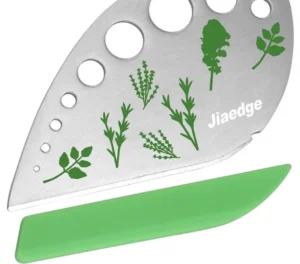Fresh herbs bring an unbeatable flavor to dishes like salads, dressings, pesto, and garnishes. However, prepping them can be a hassle compared to the convenience of dried herbs, which are ready to use right out of the jar. Fresh herbs need washing, stripping, and chopping—a process that can be quite time-consuming.
Enter the herb stripper, a handy tool that makes preparing fresh herbs much quicker and easier. As the name suggests, herb strippers help remove leaves from stems. They come with variously sized holes to fit different herbs. You simply insert the stem into the smallest hole that fits and pull it through, stripping the leaves off effortlessly. Some strippers even have large enough holes to strip greens like kale.

Certain models include a blade, allowing you to strip and chop herbs with the same tool. Others come with attached bowls to catch the leaves as they fall. This nifty gadget can revolutionize how you cook with fresh herbs, making it faster and more enjoyable. You might even find yourself using fresh herbs more often and trying out new varieties. Here are some tips to get started.
Tips for Using Fresh Herbs
First, wash and dry any fresh herbs you buy to remove dirt and pests. Wrap them in paper towels and store them in sealable bags to keep them fresh. Use them within a few days for the best flavor. Here are some popular herbs and how to use them:

Basil
Basil is loved for its sweet and slightly spicy flavor, commonly used in Mediterranean dishes and pesto. Add the leaves (not the stems) near the end of cooking to get the best flavor, whether you’re making fish, chicken, or pasta sauce.
Rosemary
Rosemary, with its woody and pine-like flavor, is perfect for the herb stripper due to its tough leaves. It pairs well with lamb, poultry, roast beef, and roasted potatoes. It’s also great on flatbread, sweet potato fries, and even in cakes.
Cilantro
Cilantro, also known as coriander leaf, has a bright, zesty flavor. Some love it, while others think it tastes like soap. It’s used in many Asian and Latin American dishes and is delicious both raw and cooked.
Dill
Dill is a staple in German and Scandinavian cuisine with a fresh, earthy flavor. It goes well with poultry, yogurt, seafood, salads, soups, and egg dishes like quiche.
Marjoram
Marjoram has a milder flavor than oregano but is still potent. It’s great with vegetables and meat and can be used in salads, soups, sauces, and fish dishes. Use the leaves in your dishes and save the stems to enhance stocks and soups.
Thyme
Thyme has a floral scent and strong flavor that enhances dishes without overpowering them. Use an herb stripper to prepare thyme easily. It pairs well with roast chicken, bread, potatoes, and even cocktails.
Mint

Mint is often associated with desserts and drinks but is versatile and can be used in salads, poultry, curries, and sandwiches. It can also add a fresh twist to a fruit salad.
Parsley
Parsley has a fresh and delicate flavor, making it a versatile herb. Use the leaves for garnish or in soups and salads. It pairs particularly well with pasta, butter, eggs, and lemon.
Oregano
Oregano has a robust flavor essential for chili, pasta, and pizza sauces. Unlike some herbs, oregano can withstand heat, so add it early in the cooking process. Use it sparingly to avoid overpowering other flavors, and save the stems for flavoring stocks and soups.
Final Thoughts
Fresh herbs can elevate your cooking, and with an herb stripper, preparing them is a breeze. This simple tool can make it easier and more enjoyable to use fresh, flavorful herbs in all your dishes, encouraging you to explore new culinary horizons.
THE END!!!!
